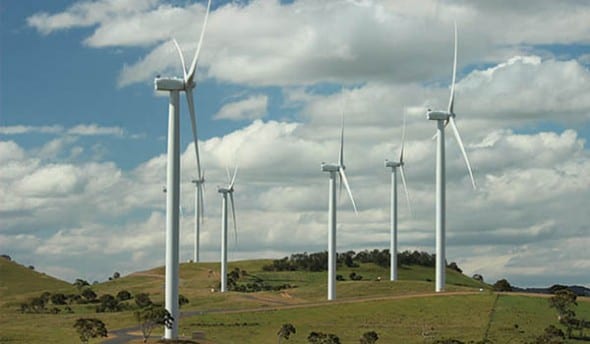After an impromptu and questionably legal airing last week, the final report of the Senate inquiry into wind farms was tabled in Parliament on Monday, with a lengthy list of recommendations that the clean energy industry says would result in the death of the wind farm sector in Australia.
The recommendations, some already adopted by the Abbott government – include the creation of an independent scientific committee on wind farm noise, national standards on the level of sound allowed to be emitted by wind farms, ongoing investigation into the health effects of “infrasound,” and new limits and restrictions to wind projects’ access to renewable energy certificates (RECs).
The report asks that the Abbott government – no fan of wind energy, as we know – to cap RECs for wind energy projects at five years, down from 15 years. And it wants those wind farms that fail to abide by a federally implemented noise limit to be barred from receiving certificates at all.

The report also states variously that a) the science on the health impacts of wind turbines is “evolving”; and b) that the RET is “promoting an unbalanced market for renewables in Australia, with an over-reliance on wind.”
I can’t think of a more efficient way to harm communities than the creation and maintenance of a fictional health scare #WindInquiry
— Ketan Joshi (@KetanJ0) August 3, 2015
The inquiry – which was headed up by outspoken anti-wind Senators John Madigan, Bob Day, Chris Back and David Leyonhjelm – was set up to address a purported “persistent and widespread complaint and criticism” of the wind industry in Australia, namely about “the lack of transparency and consultation in planning processes, and the lack of rigorous, independent research into possible health impacts of turbines.”
It also managed to squeeze in an investigation of the effect of wind energy on household power prices – “particularly households which receive no benefit from rooftop solar panels”; the merits of consumer subsidies for operators; and the effect wind turbines might have on nearby fauna and “aerial operations”.
As reported, the committee was, over the inquiry’s course, told of extraordinary damage to brain and physical function of humans, dogs and ewes, while turbines were compared to Pink Bats and the industry to Big Tobacco.
The resulting 350-page publication is, in its own words, “arguably the most complete Australian parliamentary inquiry into wind farms.”
Whether or not this is true – there have, after all, been 10 of them over the past five years – is up for debate, but it certainly rounds out one of the most comprehensive attacks on wind energy by a major political party the industry has ever seen.
“This isn’t just an attack on wind – Australia’s entire renewable energy industry would pay the price,” said committee member and Labor Senator Anne Urquhart said.
“The majority report is belligerently deaf to the expert advice that wind energy is not only safe, but it is affordable and should play a critical role in Australia’s transition to a low-carbon economy.”
“I fear this report will only serve to feed the prime minister’s blind obsession with destroying an industry that promises billions of dollars of investment and thousands of jobs in regional communities,” Urquhart said.
“If the government follows through on the recommendations in the majority report it will just cement Australia’s place as a global climate pariah with regional communities and the environment paying the price.”
To others, the report’s findings are entirely predictable – but pose no less of a reckless risk to investment in an industry that has lately been all but paralysed by uncertainty.
“You didn’t need a crystal ball to know the inquiry was going to demonise clean and safe wind energy,” said Leigh Ewbank, Friends of the Earth’s renewable energy spokesperson.
“Stacked with senators opposed to wind farms and selective leaks to the press show that the inquiry was a political exercise, not a impartial review.”
“Investors will back away from Australia if the committee’s radical recommendations are implemented. Billions of dollars worth of projects in regional areas and thousands of jobs would be lost,” said Ewbank.
Andrew Bray, national coordinator of the National Wind Alliance, said that Australia’s renewable energy policy was too important to be set by the “blinkered prejudices” of a small group of anti-wind crossbenchers.
“This report rails against anyone who challenges the bias of these anti-wind senators but treats even the most discredited criticisms of wind as gospel,” Bray said in a statement on Tuesday.
“Having failed to secure a larger cut to the Renewable Energy Target, the crossbenchers behind this inquiry now want to strangle wind development in Australia with red tape.”
“A standing ‘scientific’ committee to prolong this scare campaign about wind farms is the last thing wind communities need. The federal government should run a mile from this idea.”
Whether the Abbott government will “run a mile” from the report’s many recommendations, or seize upon them, remains to be seen – although the Committee seems confident at least some of the final recommendations will be picked up, perhaps buoyed by the Abbott government’s willing adoption of various interim recommendations, including the establishment of a national wind farm commissioner.










